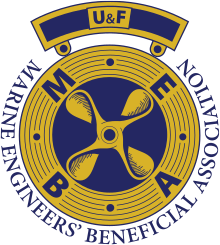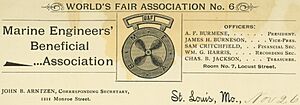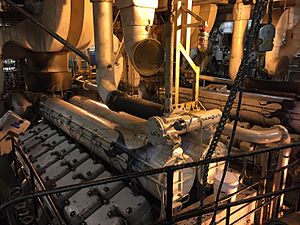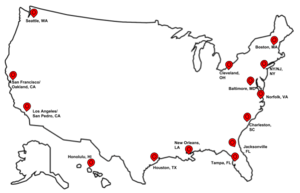Marine Engineers' Beneficial Association facts for kids
 |
|
| Abbreviation | MEBA |
|---|---|
| Formation | February 23, 1875 |
| Type | Trade union |
| Headquarters | Washington, DC, US |
| Location |
|
|
Membership (2014)
|
23,400 |
|
President
|
Adam Vokac |
|
Secretary-treasurer
|
Roland "Rex" Rexha |
| Affiliations | AFL–CIO |
|
Formerly called
|
National Marine Engineers Association |
The Marine Engineers' Beneficial Association (MEBA) is the oldest trade union for sailors in the United States. It was started way back in 1875. MEBA mainly helps licensed mariners. These are special sailors, like deck and engine officers. They work on US-flagged ships in the United States Merchant Marine. MEBA is also part of a bigger group called the AFL–CIO.
MEBA officers work on ships all over the oceans and the Great Lakes. They can be found on many different kinds of ships. This includes container ships, tankers, and even cruise ships. They also work on drillships, tugboats, and ferries. Some members work on land in the shipping industry. Others work on government ships, like those for the US Maritime Administration and the US Navy. These merchant mariners are very important. They deliver supplies to the US armed forces during conflicts.
Members of MEBA and their families get many benefits. These come from special agreements with employers. They include a Medical Plan, a 401(k) Plan, a Pension Trust, and a Vacation Plan.
Contents
How MEBA Started: A Look at Its History
The oldest maritime union in the country began out of a real need. This was in the late 1800s. When steamships first appeared in the early 1800s, more engineers were needed. These engineers had to keep the new steam engines running. Ship owners on the Mississippi River and Great Lakes wanted their ships to go faster.
However, steam engines were very new back then. The study of marine engineering was just beginning. Engineers learned on the job, often without much training. They were used to working on land. This new field was very different. Ships had engineers with little marine knowledge. The machinery was also not very reliable. Trying to go faster made the engine rooms dangerous. Fires and boiler explosions were common. Even with these risks, wages stayed low.
Making the Seas Safer: Early Laws
The many injuries and deaths on steamships finally pushed engineers to act. They asked Congress for safety rules. They wanted protection and better working conditions. In 1838, the first Steamboat Act was passed. But this law was not very clear. So, accidents on steamships kept happening.
People demanded a stronger, more effective law. This led to a new Steamboat Act in 1852. This improved law made engineers get a license to work on steamboats. It also set up a system to inspect ship machinery. This was a big step for safety.
Uniting for Strength: The Birth of MEBA
The Buffalo Association of Engineers formed in 1854. This group was a key example for other engineers. They discussed important topics like wages. They even fought against wage cuts. When wages started to drop again, other cities followed Buffalo's lead. Cleveland, Chicago, and Detroit created their own engineer groups.
These city-based groups were helpful but not strong enough alone. This led to the idea of uniting them into a national movement. The Buffalo Association started talking with other marine engineer groups. In February 1875, leaders from five steamship unions met in Cleveland, Ohio. These unions were from Buffalo, New York, Cleveland, Ohio, Detroit, Michigan, Chicago, Illinois, and Baltimore, Maryland. They decided to join together.
This new organization was first called the National Marine Engineers Association. Garret Douw of Buffalo became its first president. The word "Beneficial" was added to the name later, in 1883.
MEBA's Role in World Wars
After MEBA was formed, the union worked hard in Washington. They helped pass laws in 1884 and 1896. These laws made sure that all American ships had only American officers. They also allowed marine engineers to get licenses.
During World War I, many more engineers were needed. The US government quickly trained marine engineers. But after the war, this quick training continued. On January 20, 1919, MEBA asked to stop using "30 day engineers." They believed there were enough resources to properly train new merchant mariners.
MEBA, like many other worker unions, provided labor during World War II. They helped with both naval and engineering needs. MEBA's membership numbers have changed a lot over the years. After World War I, they had over 22,000 members. By 1934, this number dropped to 4,848. But during World War II, membership grew huge. There were job openings for about 200,000 seamen.
Training Future Engineers
The United States Naval Academy was started in the 1800s. Following this, MEBA opened its own school. The Calhoon Marine Engineers’ Beneficial Association Engineering School began in 1966. It is located in Baltimore, Maryland. This school offers over fifty courses for union members. It also trains other engineering professionals. The school even provides places for students to live.
What MEBA Offers: Union Benefits
Becoming a MEBA member comes with many benefits. MEBA provides a medical plan for members and their families. This plan includes things like prescription drugs, dental care, and mental health support. It also covers disability, life insurance, and accidental death benefits. Members just need to fill out a "Permanent Data Form."
MEBA also offers four types of Pension Plans. A pension is like a savings plan for when you retire.
- The Regular Pension Plan is for members with twenty years of work credit. They can retire at any age.
- The Reduced Pension Plan is for those with less than twenty years of credit. They must be at least sixty-five years old.
- The Early Retirement Pension is for those who want to retire early. They can do so at age sixty if they have at least fifteen years of work credit.
- The Disability Pension is for members who become permanently disabled. They can retire early if they have at least ten years of work credit.
These pensions can also be set up to help spouses, children, or in case of death.
MEBA also has a 401(k) plan. This is another way members can save for retirement. Members can choose to join this plan and name someone to receive the money if something happens to them. There is also a Vacation Plan. How much vacation a member gets depends on their work agreement. It also depends on the type of ship they work on and how many days they have worked.
Where MEBA Works: Key Locations
MEBA has its main office in Washington, DC.
- The current President is Adam Vokac (since 2021).
- The current Executive Vice President is Claudia Cimini (since 2021).
- The current Secretary-Treasurer is Roland "Rex" Rexha (since 2021).
- The current Atlantic Coast Vice President is Jason Callahan (since 2017).
- The current Gulf Coast Vice President is Adam Smith (since 2021).
MEBA works with many important port locations across the United States.
Some of these locations include:
- Seattle, Washington
- San Francisco/ Oakland, California
- Los Angeles/ San Pedro, California
- Honolulu, Hawaii
- Houston, Texas
- New Orleans, Louisiana
- Tampa, Florida
- Jacksonville, Florida
- Charleston, South Carolina
- Norfolk, Virginia
- Baltimore, Maryland
- New York/ New Jersey
- Cleveland, Ohio
- Boston, Massachusetts




